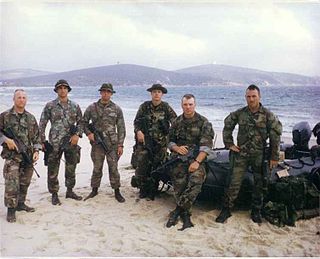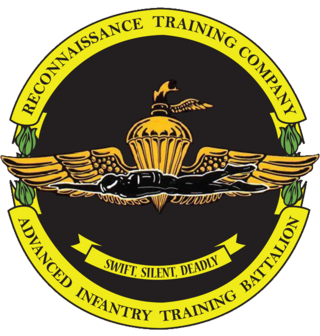
High-altitude military parachuting, or military free fall (MFF), is a method of delivering military personnel, military equipment, and other military supplies from a transport aircraft at a high altitude via free-fall parachute insertion. Two techniques are used: HALO and HAHO.

Force Reconnaissance (FORECON) are United States Marine Corps deep reconnaissance companies that supply military intelligence to the command element of the Marine Air-Ground Task Force (MAGTF). Force Reconnaissance companies unlike USMC division reconnaissance report to the Marine expeditionary force (MEF) and provide direct action and deep reconnaissance during large-scale operations.

A parachutist badge is a badge awarded by armed forces or paramilitary forces of many states to personnel who have received parachute training and completed the required number of jumps. It is difficult to assess which country was the first to introduce such an award.

Air assault is the movement of ground-based military forces by vertical take-off and landing (VTOL) aircraft, such as helicopters, to seize and hold key terrain that has not been fully secured, and to directly engage enemy forces behind enemy lines. In addition to regular infantry training, air-assault units usually receive training in rappelling, fast-roping techniques, and air transportation. Their equipment is sometimes designed or field-modified to allow better transportation and/or carrying within aircraft.

The Parachutist Badge, also commonly referred to as "Jump Wings", is a military badge of the United States Armed Forces. Some services, such as the Marine Corps, officially refer to it as an insignia instead of a badge. The United States Space Force and United States Coast Guard are the only branches that do not award the Parachutist Badge, but their members are authorized to receive the Parachutist Badges of other services in accordance with their prescribed requirements. The DoD military services are all awarded the same Military Parachutist Badge. The U.S. Army and U.S. Air Force issue the same Senior and Master Parachutist Badges while the U.S. Navy and U.S. Marine Corps issue the Navy and Marine Corps Parachutist Insignia to advanced parachutists. The majority of the services earn their Military Parachutist Badge through the U.S. Army Airborne School.

The United States Marine Corps Reconnaissance Battalions are the special operations assets of Marine Air-Ground Task Force that provide division-level ground and amphibious reconnaissance to the Ground Combat Element within the United States Marine Corps. Division reconnaissance teams are employed to observe and report on enemy activity and other information of military significance in close operations. The Military Occupational Specialty code for Reconnaissance Marine is 0321.
A parachute rigger is a person who is trained or licensed to pack, maintain or repair parachutes. A rigger is required to understand fabrics, hardware, webbing, regulations, sewing, packing, and other aspects related to the building, packing, repair, and maintenance of parachutes.

The Radio Reconnaissance Platoon is a specially trained Marine Corps Intelligence element of a United States Marine Corps Radio Battalion. A Radio Reconnaissance Team (RRT) was assigned as the tactical signals intelligence collection element for the Marine Corps Special Operations Command, Detachment One. Regular RRTs also participate in SOC operations during Marine Expeditionary Unit, or MEU(SOC), deployments.

The 1st Marine Infantry Parachute Regiment or 1er RPIMa is a unit of the French Army Special Forces Command, therefore part of the Special Operations Command.
The McGuire Rig was used to extract soldiers from the jungles of Vietnam. It would be suspended from a helicopter and used to extract soldiers from areas without a suitable pick-up zone. It was simple, inexpensive, and effective. Although less comfortable than the STABO harness, it did not require the soldiers to carry any special equipment. It was designed by Sergeant Major Charles T. McGuire, a member of Project DELTA, a Special Forces reconnaissance project.

Special reconnaissance (SR) is conducted by small units, such as a recon team, made up of highly trained military personnel, usually from special forces units and/or military intelligence organizations. Special reconnaissance teams operate behind enemy lines, avoiding direct combat and detection by the enemy. As a role, SR is distinct from commando operations, but both are often carried out by the same units. The SR role frequently includes covert direction of airstrikes and indirect fire, in areas deep behind enemy lines, placement of remotely monitored sensors, and preparations for other special forces. Like other special forces, SR units may also carry out direct action and unconventional warfare, including guerrilla operations.
Project DELTA was the first of the Reconnaissance Projects, which were special reconnaissance (SR) units named with a Greek letter. The Reconnaissance Projects were formed by the U.S. Military Assistance Command, Vietnam (MACV) during the Vietnam War to collect operational intelligence in remote areas of South Vietnam.
The Marine Corps Test Unit 1, or MCTU #1, was an experimental testing unit of the United States Marine Corps. It was established outside the Fleet Marine Force for the development of specialized tactics, techniques and organizational concepts, and to evaluate its tangible employment in the nuclear age. It reported directly to the Commandant of the Marine Corps.
The United States Marine Corps is tasked by Department of Defense directive to "conduct complex expeditionary operations in the urban littorals and other challenging environments" and "conduct amphibious operations, including engagement, crisis response, and power projection operations to assure access." Before 2006, the Marine Corps was the only branch of the Armed Forces that did not have any of its special warfare elements participating in the United States Special Operations Command (USSOCOM), due to confining its special operations capabilities only for the purpose to the Fleet Marine Force.
The Special Operations Training Group, or SOTG, is a training section of the United States Marine Corps providing Marine Expeditionary Force (MEF) commanders with training facilities and a liaison for Marine Expeditionary Units (MEU). The SOTG provides special operations training for various branches and also participates in the MEUs' Special Operations Capable Certification by acting as the "Training and Evaluation Board" for the exercises and events during the MEU annual training cycles.

The United States Marine Corps Reconnaissance Training Company trains Marines in the amphibious environment as a Reconnaissance Marine, MOS 0321. It is under the Advanced Infantry Training Battalion (AITB) of the School of Infantry (West), Marine Corps Base Camp Pendleton, California.

1st Force Reconnaissance Company conducted deep reconnaissance and direct action raids in support of I Marine Expeditionary Force requirements across the range of military operations to include crisis response, expeditionary operations and major combat operations. 1st Force Recon Company was deactivated on 26 October 2006 and the majority of the personnel were used to establish the 1st Marine Special Operations Battalion.

Helicopter Rope Suspension Technique (HRST) is a military term for techniques and methods of rappelling, fast roping, Special Patrol Insertion/Extraction (SPIE) and Jacob's Ladder operations. Helicopter Rope Suspension was developed as a means to insert and/or extract, by helicopter, ground forces into or from rough terrain, urban areas or water. HRST is designed to be used in situations wherein aircraft landings are impractical due to terrain or tactical situation.
The STABO extraction harness was a device which allowed military personnel to be rescued from field locations which prevented the conventional landing and boarding of a helicopter.

Aircrew survival equipmentmen are survival equipment specialists and certified parachute riggers who oversee valuable life saving equipment, parachutes, and other special gear used by U.S. Naval and Marine Corps special operations forces, Naval Air Department, and the United States Navy Parachute Team known as the "Leap Frogs". They perform a wide range of duties, which include inspecting, maintaining, and repairing parachutes, search and rescue equipment, along with survival kits, medical kits, flight clothing, protective wear, night vision equipment, aircrew oxygen systems, liquid oxygen converters, anti-exposure suits, and g-suits. PRs operate and maintain carbon dioxide transfer and recharge equipment, operate and repair sewing machines as well as train aircrew and other personnel in parachute rigging and the use of safety and survival equipment.














